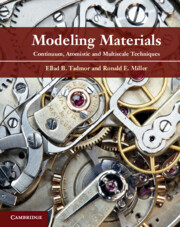Book contents
- Frontmatter
- Contents
- Preface
- Acknowledgments
- Notation
- 1 Introduction
- Part I Continuum mechanics and thermodynamics
- Part II Atomistics
- Part III Atomistic foundations of continuum concepts
- 7 Classical equilibrium statistical mechanics
- 8 Microscopic expressions for continuum fields
- 9 Molecular dynamics
- Part IV Multiscale methods
- Appendix A Mathematical representation of interatomic potentials
- References
- Index
7 - Classical equilibrium statistical mechanics
from Part III - Atomistic foundations of continuum concepts
Published online by Cambridge University Press: 05 June 2012
- Frontmatter
- Contents
- Preface
- Acknowledgments
- Notation
- 1 Introduction
- Part I Continuum mechanics and thermodynamics
- Part II Atomistics
- Part III Atomistic foundations of continuum concepts
- 7 Classical equilibrium statistical mechanics
- 8 Microscopic expressions for continuum fields
- 9 Molecular dynamics
- Part IV Multiscale methods
- Appendix A Mathematical representation of interatomic potentials
- References
- Index
Summary
Statistical mechanics provides a bridge between the atomistic world and continuum models. It capitalizes on the fact that continuum variables represent averages over huge numbers of atoms. But why is such a connection necessary? The theory of continuum mechanics is an incredibly successful theory; its application is responsible for most of the engineered world that surrounds us in our daily lives. This fact, combined with the internal consistency of continuum mechanics, has led some of its proponents to adopt the view that there is no need to attempt to connect this theory with more “fundamental” models of nature. (See, for example, the discussion of Truesdell and Toupin's view on this in Section 2.2.1.) However, there are a number of reasons why making such a connection is important.
First, continuum mechanics is not a complete theory since in the end there are more unknowns than the number of equations provided by the basic physical principles. To close the theory it is necessary to import external “constitutive relations” that in engineering applications are obtained by fitting functional forms to experimental measurements of materials. Continuum mechanics places constraints on these functional forms (see Section 2.5) but it cannot be used to derive them. A similar state of affairs exists for failure criteria, such as fracture and plasticity, which are add-ons to the theory. There is a strong emphasis in modern engineering to go beyond the phenomenology of classical continuum mechanics to a theory that can also predict the material constitutive response and failure.
Information
- Type
- Chapter
- Information
- Modeling MaterialsContinuum, Atomistic and Multiscale Techniques, pp. 377 - 439Publisher: Cambridge University PressPrint publication year: 2011
